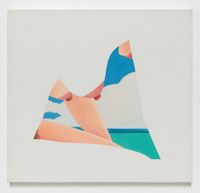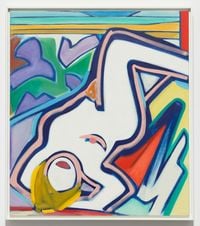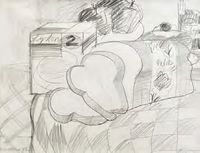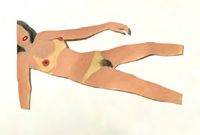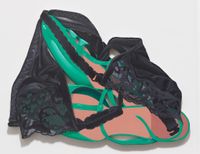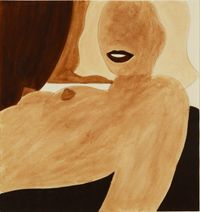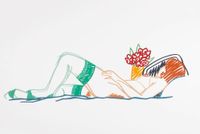Tom Wesselmann was an American artist and is best known for his colourful shaped canvases of abstracted female nudes in bathroom, kitchen or bedroom settings.
Read MoreWesselmann's artworks sometimes incorporated real items such as plastic shower curtains, faucets, toilet seats, functioning radios or televisions, and in one wall-inserted boxed still life entitled Bedroom Tit Box (1968-70), a human breast, its reclining owner hidden on the other side of the wall. He also made collages and screenprints of still lifes and landscapes, and very large freestanding sculptures (1967-81) that clung to the wall, depicting cosmetic-related boudoir objects.
In 1949-51 Wesselmann attended Hiram College in Ohio and the University of Cincinnati, hoping to study psychology, but getting drafted into the army prevented that. He became interested in cartooning, so he studied drawing in the Art Academy of Cincinnati. In 1956 Wesselmann shifted to Cooper Union in New York where, while visiting MoMA, he was greatly drawn to Abstract Expressionist paintings by Motherwell and de Kooning.
However Wesselmann soon realised his own aesthetic was not turbulent or expressive, and began doing landscapes and small collages like Still Life #3 (1962) (using magazine ads) in the late fifties, then to do much larger ones (made from billboards) like Still Life #33 (1963). He also included female nudes in bedrooms in close proximity to items on dressing tables. They started in the early sixties after his first marriage collapsed. At a certain stage he stopped using large collages and began painting everything. The abstracted nudes then evolved from painted canvas images to those of moulded Plexiglass, like Little Nude (1966).
Wesselmann's interest in collage led him to making paintings with female body parts or adorning accoutrements often in isolation, such as lips, feet, cigarettes, their curling smoke, or stocking tops, presenting evocative semi-flat shapes with a fetishistic ambience. Contrasting images of male body parts were more realistic (though ambiguously similar to horizontal landforms or domestic furniture: Bedroom Painting #19 (1969); Seascape #27 (1967-69)); sometimes with the erotic female elements, shaped canvases—with curved negative spaces—were utilised. (Girl eating a banana (1967-68); Bedroom Painting #67 (1983)).
Wesselmann once stated that he considered himself a formalist, being interested in how images were made, and not in making a political critique of consumerism. He disliked being called a Pop artist because he did not see himself as attacking the sale of commodities or commenting on the pervasiveness of advertising.
Because of figure paintings like the Great American Nudes series (1961-73), where the female form consisted of flat white silhouettes peppered by hair, mouth, nipples, nails and pubes, such abstraction aroused feminist ire at its 'objectification,' with some curators like Brenda Schmahmann and Chris Sharp defending him as depicting desiring (not passive) women, and certainly not being misogynistic.
In the mid-eighties Wesselmann (with metalworks fabricator Alfred Lippincott) developed a series of linear works where fluid and quickly rendered drawings were laser cut from steel sheets so that the configuration of connected coloured lines could be hung intact on the wall like a painting. Organised in multiples, landscapes, nudes and flower arrangements were usually depicted. (For example, Steel Drawing / Wildflower Bouquet Edition (1987))
Standing Still Lifes, Gagosian, New York, 2018
A Different Kind of Woman, Almine Rech, Paris, 2016
Beyond Pop Art: A Tom Wesselmann Retrospective, Denver Art Museum, Denver, 2014
Tom Wesselmann: Collages (1959-64), David Zwirner, London, 2014
Painted Black. Steel Drawings by Tom Wesselmann, David Janis Gallery, New York, 2012
Tom Wesselmann: Drop-Out, Yvon Lambert Gallery/Maxwell Davidson Gallery, New York City, 2007
On Everyone's Lips, From Pieter Bruegel to Cindy Sherman, Kunstmuseum, Wolfsburg, 2020
BLAM! The Explosion of Pop, Minimalism & Performance 1958—64, Whitney Museum of American Art, 1984
MoMA, New York
Walker art Centre, Minneapolis
Hirshhorn Museum, Washington, D.C.
Whitney Museum of American Art, New York
Musée d'Art Moderne et d' Art Contemporain, Paris
Nationalgalerie, Berlin
Articles on Tom Wesselmann can be found in Frieze, Christies, and in The Guardian.
John Hurrell | Ocula | 2021
